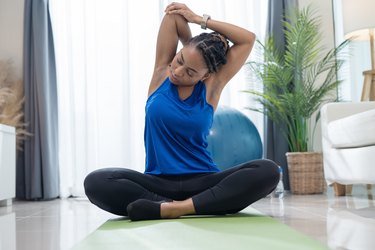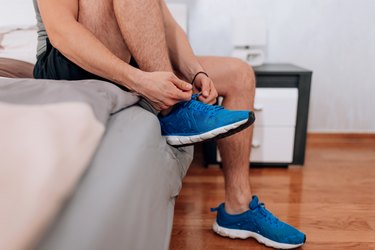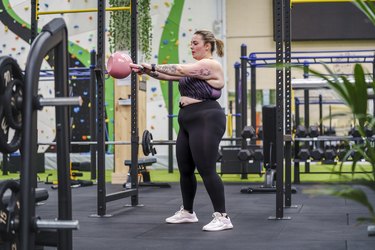
If you follow a wellness-driven morning routine, you might jump-start your day with a nutritious, satisfying breakfast, some meditation or breathwork or a light walk around the block to wake up your body and mind. Those morning habits are surely beneficial, but there might be one valuable practice missing from your a.m. schedule: mobility work.
Simply put, mobility is the ability to actively move a joint through its full range of motion without any restriction, says Kelsey Decker, CPT, a NSCA-certified personal trainer and the manager of training and experiences at StretchLab. The better mobility you have, the easier it will be to, say, lower down into a squat or lift your arms overhead, she tells LIVESTRONG.com. But that's not the only reason to improve your range of motion.
Video of the Day
Video of the Day
Here, personal trainers highlight the importance of mobility training and share the practices they implement in their own morning routines to increase their mobility.
Tip
There’s no single best practice to improve your mobility, and some stretches and activities may feel better for your body than others. So choose one or two of the trainer-approved movement practices below, try them out for a few weeks and switch up your routine as needed.
The Importance of Mobility
Along with improving everyday functioning, increasing joint mobility helps ensure you're getting the most out of your workouts. If you're short on shoulder mobility, for example, you might not be able to lower your chest all the way down to the ground for a push-up.
While it's beneficial to work through the entire range of motion that's currently available to you — and not push yourself past it — improving your mobility over time can make the exercise at hand more effective. In the push-up example above, lowering your chest until it's aligned with your elbows and pushing back up to a high-plank position will increase the workload placed on your upper-body muscles.
Mobility also plays a key role in injury prevention, says Tina Tang, CPT, RKC, SFL, a NCSF-certified personal trainer and strength coach. If you have limited range of motion in your shoulder and are attempting to do a heavy overhead press, you might compensate your movement pattern to complete the rep, which can lead to injury, she tells LIVESTRONG.com.
To determine if you could benefit from a mobility routine, think about how you move in your everyday life, Decker says. Is it difficult for you to put a box of cereal on top of the fridge or squat down to pick up your cat? If you're not moving as freely and fluidly as you'd like or you notice a limited range of motion during your typical actions, take it as a sign to work on your mobility, she suggests.
To get more technical, consider doing an overhead squat test, which is often used at StretchLab to track how well the body can move, Decker adds.
As you squat with your arms raised over your head, take note of how low you're able to sink down to the floor (which can be affected by knee and hip mobility), if you can keep your heels flat on the ground (which can be affected by ankle mobility) and if you can keep your elbows straight (which can be influenced by shoulder mobility), Decker says. Of course, a personal trainer can help you decipher any mobility restrictions and how to best correct them.
6 Morning Habits for Better Mobility That Trainers Do Themselves
To build up your mobility, you need to get moving, hence the expression "motion is lotion" for your joints, Tang says. "It's the same as a car: If you don't use the car — even if it's in great shape — the metal fixtures will get rusty and the engine's not going to work as well," she says. "The more you move, the better your body moves."
Adding mobility work to your morning schedule can be particularly valuable, Decker says. "If you start the day with some mobility — some stretches, some lunges, working on breathing to increase the blood flow and oxygen in your body — that's going to set the tone for the rest of the day of how your body is able to move," she explains. "It may even create good habits of not wanting to sit and incorporating good mobility stretches throughout the day."
Need inspiration for your own morning routine? Consider these personal trainer-approved mobility practices.
1. Do a 5-Minute Stretch Series
Recently, Decker has been kicking off her morning with a 5-minute practice of light stretches. "Specifically for my body, I definitely feel a lot of tension in my lower back, so I try to get into a child's pose, where I'm opening up through the hips a little bit more but also lengthening through my spine because I'm reaching long out in front of me," she says.
Decker also performs T-spine rotations in child's pose, twisting through her spine and lifting one arm up toward the ceiling, to work on thoracic mobility. To target her legs, she'll practice a kneeling lunge stretch, leaning into her front leg to open up the back leg's quad muscle, she says.
In addition to improving range of motion, "5 minutes of just a little bit of movement helps awaken the body, which is going to make you feel a little bit more alert as you're getting into calls, meetings or answering emails for the day," Decker says.
2. Foam Roll the Muscles Surrounding Tight Joints
If you're dealing with limited hip mobility, for instance, consider foam rolling the muscles surrounding that joint, including your hamstrings, glutes and quads, Decker suggests. Once they loosen up, you may see an improvement in your hips' range of motion, she notes.
"I love to use a foam roller in conjunction with stretching," Decker adds. "I would start with a foam roller to hit those [surrounding] areas and then go through the range of motion with PNF [proprioceptive neuromuscular facilitation] stretching." PNF stretching, which involves contracting and relaxing a muscle repeatedly to create a deeper stretch, may help increase joint range of motion, according to a May 2018 review in the Journal of Sport Rehabilitation.
3. Target the Muscles Around Previously Injured Areas
If you've dealt with joint injuries over the years, you may benefit from focusing a portion of your morning mobility routine on those recovered areas, just like Tang. She prioritizes exercises, such as kneeling lat stretches and side-lying thoracic rotations, that assist in improving mobility throughout her shoulder, which she once injured.
Similarly, Bradford Rahmlow, CPT, CES, SFS, a NASM-certified personal trainer and the head of trainer talent at Balanced, targets his calves, which are tight from his years as a professional dancer. This stiffness has impacted his ankle mobility and consequently led to Achilles tendonitis, he tells LIVESTRONG.com.
"Oftentimes, the mobility in the joint is not limited to the muscles surrounding the joint, so my ankle mobility is directly related to how pliable my entire posterior chain is," he explains. "When I'm doing mobility work for my ankle, I'm actually stretching my calf muscles, my hamstrings and some of my back muscles to get the proper range of motion in all of the muscles and joints that are involved with the ankle."
If you're currently suffering a joint injury, make sure to get the green light from your doctor or physical therapist before foam rolling the affected area.
4. Flow Through a Yoga Practice
Moving through a yoga practice not only settles your mind, but it can also help improve mobility, according to Rahmlow. "I prioritize getting in a yoga class at least once a week for myself in the morning or the evening, just to connect to my body, connect the breath to the movement and to really create a space for that body-mind awareness for targeted mobility," he says.
By improving the flexibility of your muscles, making them more elastic, yoga can also increase mobility, Decker says. In fact, a January 2016 review in Age and Aging found that practicing yoga is linked to "medium improvements" in mobility in people aged 60 and older.
"If you have any restriction or tension within your fascia or muscles, that's going to restrict the ability to be mobile," Decker explains. "It's going to limit how well you're able to get into that full range of motion. You need to increase your flexibility, limiting any tension or tightness that you have, to help the range of motion."
5. Focus on These Specific Joints if You're a Desk Worker
Folks who sit at a desk all day could benefit from mobility work that targets the hips, wrists and scapulae — joints that can become particularly stiff in this position, Rahmlow says. You might try 90/90 hip stretches, which are one of Rahmlow's favorite floor movements, to target the hip joints, which are stuck in a flexed position in your desk chair.
Your wrists are also important: "I think a lot of us that work at desks tend to forget that our wrists need some mobility, but we're constantly in that flexed position when we're typing or when we're using a mouse," he says. "Being in a load-bearing position on all fours, and then flipping one hand underneath you so you're on the tops of your knuckles is a really great stretch."
Sitting in a chair, hunched over a desk can also cause your shoulder blades to sit in a protracted position for an extended period and cause tightness, Rahmlow says. However, scapular protraction and retraction drills — during which you pull the shoulder blades together and push them apart in a high-plank position — help create space in your upper back, alleviate tension and improve shoulder mobility, he adds. "That's also a great example of why mobility is not just stretching, because in order to be able to move your shoulder blades freely, you have to actually activate muscles to get them to move," he explains.
6. Practice Tai Chi
If yoga isn't your cup of tea, try Tang's favorite morning practice: tai chi, which involves performing slow, gentle movements and physical postures, according to the National Center of Complementary and Integrative Health (NCCIH).
"Tai chi is helpful because you're moving your body gently, waking it up and you have to be very present as you're doing the moves because you're trying to remember the next move," she explains. "I think also the ranges of motion, depending on the type of tai chi you do, can be a little less extreme [than yoga], but it can get you into positions where you need to be very mobile."
- Journal of Sports Rehabilitation: "The Effectiveness of PNF Versus Static Stretching on Increasing Hip-Flexion Range of Motion"
- Age and Aging: "Yoga-based exercise improves balance and mobility in people aged 60 and over: a systematic review and meta-analysis"
- NCCIH: "Tai Chi: What You Need To Know"


